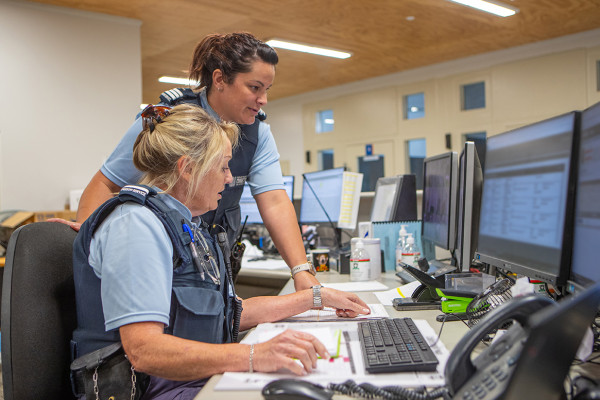2 February 2024
The different environments our Corrections Officers work in
When people initially picture a Corrections Officer role, they may picture someone working with a group of prisoners in a “unit” or cell block.
While true, there’s also a lot of diversity in what that looks like. For Corrections Officers working in low security, for example, their day will involve more “unlock” time for prisoners, whereas for those working in high security, activity is more strictly monitored, with higher staff to prisoner ratios.
There are also opportunities to take up positions in focus units such as Mothers with Babies Units (MBUs), Drug and Alcohol Treatment Units (DTUs), or Intervention and Support Units (ISUs)… and that’s just looking at work inside a unit. Outside of the units, our Corrections Officers work in other areas of the prison such as the Gatehouse, the Health Centre, the Receiving Office, or Master Control.
In this article, we look at some of the different environments that you could work in as a Corrections Officer.
While we can’t cover all the areas that our Corrections Officers work in, we hope it helps to give you a sense of the opportunities to work in different settings and grow your skills.
Different areas across the prison
Across the prison, there are a range of different areas where our Corrections Officers could be working. Some of our Corrections Officers, for example, supervise the Health Centre, supporting our nurses in their work and making sure they’re safe.
Others work in the Receiving Office. The Receiving Office is the first point of contact for new prisoners and there are a range of checks that are carried out by the Receiving Office team before a new prisoner moves into a unit.

Corrections Officers working in the Receiving Office
Another specialist area of the prison is Master Control, which is where Senior Corrections Officer Lynn works. Her role in Master Control is to manage staff, visitors, and vehicles through the Gatehouse.
This involves taking radio calls from staff and escort vans, managing movements in and out of the prison throughout the day, monitoring escorts, answering phone and radio calls, and asking staff to respond to incidents on site.
Lynn was asked if she wanted to move into the position permanently after working in the Gatehouse and having the opportunity to do the odd shift in Master Control.
“That was a few years ago and I’m still here and enjoying it. I like the hustle and bustle of working here in Master Control. You really have to multitask and be able to prioritise. When an incident occurs, we need to be on our toes. We watch monitors and can see things that officers in the units might miss.”
Specialist units
There are also specialist units that Corrections Officers can have the opportunity to work in. These units provide the opportunity to work in a unit with a specific focus.
Adeel is a Corrections Officer working in the Rata unit, which is focused on employment. He says his routine is slightly different to general units, as the men that he manages go to work each day, as part of a programme called Release to Work. The Release to Work programme allows minimum security prisoners, who are assessed as suitable, to safely engage in paid employment in the community.
He says that as well as having a different daily routine to other units, the people he manages are at a different stage in their journey within Corrections.
“In the unit I’m in, we work with men who are close to being released and have been through certain programmes to address their offending. So, with us it’s the time for maintenance - they need to maintain all of the learning that they have gained through their sentence.”
The Rata unit is just one example of a focus unit. Others include our Drug and Alcohol Treatment Units, Youth Units (for prisoners under 20), Pasifika Units, Māori and Tikanga focused units, self-care units, Mothers and Babies Units (MBUs) and Special Treatment Units (STUs).
Different security levels and prisoner classifications
As well as different focus units and areas of the prison, there are also different security levels and prisoner classifications. Men’s and women’s prisons also may have different programmes or approaches.
This can influence both the daily routines of our Corrections Officers, and the types of issues that may need to resolve.
Prisoners on remand, for example, are awaiting their trial or sentencing and have different needs than those who have already been sentenced. They may need to access lawyers, prepare for court appearances, and seek suitable accommodation for bail.
Whether it’s in a remand or sentenced unit, a women’s prison or men’s, high security or low - there’s always opportunities to try out different areas and discover new aspects of our work. Understanding different areas may even help in the area that you’re usually based in - for example, knowing what the sentenced environment is like may help in preparing remand prisoners on what to expect if they are sentenced.
If you’re curious about learning more about some of our different units or areas, check out the pages below:
1 News visits Mothers with Babies unit
Wāhine: E Rere Ana Ki te Pae Hou Women's Strategy 2021 - 2025
Ready to make a move?
Start your journey - check out the a list of our current opportunities then apply online today!